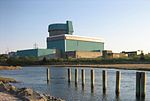Brookhaven State Park
1971 establishments in New York (state)Brookhaven, New YorkLong Island geography stubsParks in Suffolk County, New YorkProtected areas established in 1971 ... and 2 more
State parks of New York (state)Use mdy dates from August 2023
Brookhaven State Park is a 1,638-acre (6.63 km2) state park in Wading River and Ridge, New York, approximately 74 miles (119 km) east of New York City. Established in 1971, the park land was formerly the property of Brookhaven National Laboratory. Protecting a large amount of the Long Island Pine Barrens, the park also contains scattered wetlands.Brookhaven State Park is located along the east side William Floyd Parkway, between NY 25 and NY 25A. The park contains 25 miles (40 km) of multi-use trails.
Excerpt from the Wikipedia article Brookhaven State Park (License: CC BY-SA 3.0, Authors).Brookhaven State Park
William Floyd Parkway,
Geographical coordinates (GPS) Address Phone number Website External links Nearby Places Show on map
Geographical coordinates (GPS)
| Latitude | Longitude |
|---|---|
| N 40.922222222222 ° | E -72.866666666667 ° |
Address
Brookhaven State Park
William Floyd Parkway
11961
New York, United States
Open on Google Maps







